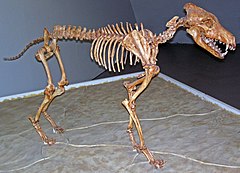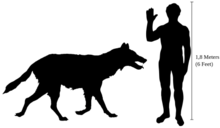恐狼 - 维基百科,自由的百科全书
| 恐狼 | |
|---|---|
 | |
| 恐狼的全身骨架,展於施滕貝格自然史博物館 | |
| 科学分类 | |
| 界: | 动物界 Animalia |
| 门: | 脊索动物门 Chordata |
| 纲: | 哺乳纲 Mammalia |
| 目: | 食肉目 Carnivora |
| 科: | 犬科 Canidae |
| 属: | †恐狼屬 Aenocyon Merriam, 1918 |
| 种: | †恐狼 A. dirus |
| 二名法 | |
| †Aenocyon dirus | |
| 亞種 | |
| 異名 | |
恐狼(學名:Aenocyon dirus)是已滅絕的犬科動物,也是北美洲著名的史前肉食動物,生活於更新世晚期至全新世早期(125,000–9,440 年前)的美國。雖然牠與灰狼有關,但卻不是任何現存物種的直系祖先。恐狼與灰狼在北美洲一同生存了約十萬年。
恐狼的第一個標本是由Francis A. Linck於1854年沿美國俄亥俄河在近印第安納州埃文斯維爾的鴿子河河口發現,而大部份的化石則在加里福尼亞州的拉布雷亞瀝青坑中發現。
恐狼的體型與現今的灰狼(學名:Canis lupus)相近,C. d. guildayi的體重平均為60公斤(132英磅)而C. d. dirus則為68公斤(150磅)。顱骨與齒列近似灰狼,但強壯的頜骨與較大的牙齒顯示恐狼擁有所有犬屬中最強的咬合力。較強的咬合力使得恐狼更有能力獵捕更新世巨型動物群,包括當時同樣棲息於北美洲的加州西方野馬、地懶、乳齒象、古風野牛與擬駝。恐狼可能像現今的犬屬頂級掠食者一樣是採群體獵食的形式。恐狼在第四紀滅絕事件中與其他北美洲的巨型動物群一同滅絕[8][9],也包括其他肉食動物,例如:巨型短面熊、美洲擬獅、斯劍虎、似劍齒虎、北美獵豹與豺,大約在克洛維斯人到達北美洲之後。恐狼滅絕的原因可能肇因於對巨型草食動物的依賴、氣候變遷、以及與其他掠食者的競爭,目前的樣本顯示恐狼一直到 9,440 年前才完全滅絕。[10][11]
分類學
[编辑]DNA證據
[编辑]| 現存與已滅絕的犬科動物DNA親緣關係 | |||||||||||||||||||||||||||||||||
|
DNA分析研究顯示恐狼來自美洲古老的演化支,與現存的犬科為兩獨立的支序[12]。
1992年曾經試圖從恐狼亞種(A. d. guildayi)的化石樣本上抽取粒線體DNA以比較其與其他犬科物種的親緣關係,然而這些來自拉布雷雅瀝青坑的樣本由於焦油黏著的關係,最終並無法成功地抽取到DNA[13]。2014年也曾嘗試從瀝青坑中哥倫比亞猛獁的樣本身上抽取DNA,同樣以失敗告終,結論是這些來自瀝青坑的化石,其內部都已經被瀝青等有機物質滲透,阻礙了DNA的抽取[14]。
2021年,研究者對5具出土於13,000年至50,000年前的恐狼化石進行了DNA測序。發現恐狼與其他似狼的犬科的最近共同祖先出現於570萬年前,也因此恐狼與現存灰狼形態學上的高度相似可能僅是高度的趨同演化。似狼犬科傳統上均有雜交的紀錄,但研究顯示這5隻恐狼個體並沒有與灰狼、郊狼、或是牠們的共同祖先有任何的基因混合。這也證實了恐狼是獨立於其他似狼犬科的演化支[12] 。
該研究提出,自570萬年前恐狼與其他似狼犬科分家後,就在美洲獨立演化,並產生了生殖隔離。而灰狼、郊狼、豺、以及已滅絕的異豺則是於晚更新世時才從歐亞大陸遷移至北美洲,也因此並無法與恐狼發生雜交。長期獨力演化的恐狼演化支也代表著,其他早期發現於美洲的安布魯斯特狼(C. armbrusteri)與愛德華狼(C. edwardii)可能也屬於同一演化支。總結該研究,恐狼不再屬於犬屬(Canis),而是屬於獨立的恐狼屬,採用先前研究所提出的學名Aenocyon[12]。
化石紀錄
[编辑]

在拉布雷亞瀝青坑中,恐狼的數目非常之多,總數超過3600頭,比所有其他的哺乳動物更多。由此可見,恐狼可能像現今的狼或狗般是群體獵食的,並且得知當時物種在接近滅絕時所承受的壓力。
埃文斯維爾恐狼
[编辑]於1854年夏季當俄亥俄河的水位較低時,在美國印第安納州埃文斯維爾發現了恐狼的模式標本。這個標本是一個化石化的顎骨,由Joseph Granville Norwood博士從Francis A. Linck處獲得。他把這個標本交予約瑟夫·萊迪(Joseph Leidy)研究,萊迪確定這個標本屬於狼的一個已滅絕物種,並於1854年發表。於1858年的文獻中,萊迪將這個標本命名為恐狼。[15]
Norwood博士在交予約瑟夫·萊迪恐狼標本的信中提及另有一個標本已交回Linck處,但因Linck已於1854去世,故未能確定。這封信及恐狼的模式標本現今存放在費城自然科學院。
描述
[编辑]
恐狼是目前已知體型最大的犬屬[16][17]:52。牠們的身形比例類似於兩種現存於北美洲的狼:阿拉斯加內陸狼(Canis lupus pambasileus)[16][18]以及馬更歇狼(Canis lupus occidentalis)[18]。現存體型最大的狼肩高約 97 cm(38英寸),體長約 180 cm(71英寸)[19]:1。一些拉布雷亞瀝青坑出土的樣本小於這個體長,但也有大於這個體長的樣本[16]。
和同體型大小的北方狼做為比較,恐狼具有較小的腳掌以及較大的頭顱。頭顱的長度可超過 310 mm(12英寸),具有較寬的齶、額骨與顴弓,更高聳的矢狀嵴,這讓恐狼的頭顱看起來特別巨大。

C. d. guildayi 的體重估計平均約 60公斤(130磅),而 C. d. dirus 的體重則估計平均約 68公斤(150磅) ,且有更大型的個體存在[20],但由於骨架限制[21]因此不會超過 110公斤(240磅)。相比之下,阿拉斯加內陸狼雄性體重平均為 43公斤(95磅),雌性則為 37公斤(82磅)。體重的範圍大致在 21公斤(46磅) 至 55公斤(121磅) 之間[22],最高紀錄可達到 79.4公斤(175磅)[19]:1。恐狼的平均體型大約與灰狼的最大體型相近似[20]。
完整的雄性恐狼化石辨識度十分高,因為其具有和其他犬科外型差異甚大的陰莖骨[23][24]。
參考文獻
[编辑]- ^ Leidy, J. Notice of remains of extinct vertebrata, from the Valley of the Niobrara River, collected during the Exploring Expedition of 1857, in Nebraska, under the command of Lieut. G. K. Warren, U. S. Top. Eng., by Dr. F. V. Hayden, Geologist to the Expedition, Proceedings. Proceedings of the Academy of Natural Sciences of Philadelphia. 1858, 10: 21 [2018-07-20]. (原始内容存档于2016-12-01).
- ^ 2.0 2.1 Kurten, B. Geographic differentiation in the Rancholabrean dire wolf (Canis dirus Leidy) in North America. Genoways, H. H.; Dawson, M. R. (编). Contributions in Quaternary Vertebrate Paleontology: A Volume in Memorial to John E. Guilday. Special Publication 8. 卡內基自然史博物館. 1984: 218–227. ISBN 978-0-935868-07-4.
- ^ Leidy, J. Notice of some fossil bones discovered by Mr. Francis A. Lincke, in the banks of the Ohio River, Indiana. Proceedings of the Academy of Natural Sciences of Philadelphia. 1854, (7): 200 [2018-07-20]. (原始内容存档于2020-12-01).
- ^ Leidy, J. The extinct mammalian fauna of Dakota and Nebraska, including an account of some allied forms from other localities, together with a synopsis of the mammalian remains of North America. Journal of the Academy of Natural Sciences of Philadelphia. 1869, 7: 368 [2018-07-20]. (原始内容存档于2021-02-02).
- ^ Allen, J. A. Description of some remains of an extinct species of wolf and an extinct species of deer from the lead region of the upper Mississippi. American Journal of Science. 1876, s3–11 (61): 47–51 [2018-07-20]. doi:10.2475/ajs.s3-11.61.47. (原始内容存档于2021-01-28).
- ^ Sellards, E.H. Human remains and associated fossils from the Pleistocene of Florida. Annual Report of the Florida Geological Survey. 1916, 8: 152 [2018-07-20]. (原始内容存档于2021-02-01).
- ^ Frick, C. Alaska's frozen fauna. Natural History. 1930, (30): 71–80.
- ^ O'Keefe, F.R.; Fet, E.V.; Harris, J.M. Compilation, calibration, and synthesis of faunal and floral radiocarbon dates, Rancho La Brea, California (PDF). Contributions to Science. 2009, 518: 1–16 [2018-07-20]. (原始内容 (PDF)存档于2017-07-03).
- ^ O'Keefe, F.Robin; Binder, Wendy J.; Frost, Stephen R.; Sadlier, Rudyard W.; Van Valkenburgh, Blaire. Cranial morphometrics of the dire wolf, Canis dirus, at Rancho La Brea: temporal variability and its links to nutrient stress and climate. Palaeontologia Electronica. 2014, 17 (1): 1–24 [2018-07-20]. (原始内容存档于2018-12-16).
- ^ Kurten, B.; Anderson, E. 11-Carnavora. Pleistocene mammals of North America. Columbia University Press, New York. 1980: 168–172. ISBN 978-0-231-03733-4.
- ^ Anderson, Elaine. Chapter 2: Who's who in the Pleistocene. Paul S. Martin; Richard G. Klein (编). Quaternary Extinctions: A Prehistoric Revolution. University of Arizona Press, Tucson. 1984: 55 [2018-07-20]. ISBN 0-8165-1100-4. (原始内容存档于2019-06-09).
- ^ 12.0 12.1 12.2 Perri, Angela R.; Mitchell, Kieren J.; Mouton, Alice; Álvarez-Carretero, Sandra; Hulme-Beaman, Ardern; Haile, James; Jamieson, Alexandra; Meachen, Julie; Lin, Audrey T.; Schubert, Blaine W.; Ameen, Carly; Antipina, Ekaterina E.; Bover, Pere; Brace, Selina; Carmagnini, Alberto; Carøe, Christian; Samaniego Castruita, Jose A.; Chatters, James C.; Dobney, Keith; Dos Reis, Mario; Evin, Allowen; Gaubert, Philippe; Gopalakrishnan, Shyam; Gower, Graham; Heiniger, Holly; Helgen, Kristofer M.; Kapp, Josh; Kosintsev, Pavel A.; Linderholm, Anna; Ozga, Andrew T.; Presslee, Samantha; Salis, Alexander T.; Saremi, Nedda F.; Shew, Colin; Skerry, Katherine; Taranenko, Dmitry E.; Thompson, Mary; Sablin, Mikhail V.; Kuzmin, Yaroslav V.; Collins, Matthew J.; Sinding, Mikkel-Holger S.; Gilbert, M. Thomas P.; Stone, Anne C.; Shapiro, Beth; Van Valkenburgh, Blaire; Wayne, Robert K.; Larson, Greger; Cooper, Alan; Frantz, Laurent A. F. Dire wolves were the last of an ancient New World canid lineage. Nature. 2021. PMID 33442059. doi:10.1038/s41586-020-03082-x.
- ^ Janczewski, D. N.; Yuhki, N.; Gilbert, D. A.; Jefferson, G. T.; O'Brien, S. J. Molecular phylogenetic inference from saber-toothed cat fossils of Rancho La Brea. Proceedings of the National Academy of Sciences of the United States of America. 1992, 89 (20): 9769–73. Bibcode:1992PNAS...89.9769J. PMC 50214
 . PMID 1409696. doi:10.1073/pnas.89.20.9769.
. PMID 1409696. doi:10.1073/pnas.89.20.9769. - ^ Gold, David A.; Robinson, Jacqueline; Farrell, Aisling B.; Harris, John M.; Thalmann, Olaf; Jacobs, David K. Attempted DNA extraction from a Rancho La Brea Columbian mammoth (Mammuthus columbi): Prospects for ancient DNA from asphalt deposits. Ecology and Evolution. 2014, 4 (4): 329–36. PMC 3936381
 . PMID 24634719. doi:10.1002/ece3.928.
. PMID 24634719. doi:10.1002/ece3.928. - ^ Clark Kimberling. David Dale Owen and Joseph Granville Norwood: Pioneer Geologists in Indiana and Illinois. Indiana Magazine of History (Indiana University). 1996, 62: 2–25.
- ^ 16.0 16.1 16.2 Merriam, J. C. The fauna of Rancho La Brea, Part II. Canidae.. Memoirs of the University of California. 1912, 1: 217–273.
- ^ Wang, Xiaoming; Tedford, Richard H. Dogs: Their Fossil Relatives and Evolutionary History. Columbia University Press, New York. 2008: 1–232 [2018-11-15]. ISBN 978-0-231-13529-0. (原始内容存档于2019-06-13).
- ^ 18.0 18.1 Tedford, Richard H.; Wang, Xiaoming; Taylor, Beryl E. Phylogenetic Systematics of the North American Fossil Caninae (Carnivora: Canidae) (Submitted manuscript). Bulletin of the American Museum of Natural History. 2009, 325: 1–218 [2018-11-15]. doi:10.1206/574.1. (原始内容存档 (PDF)于2020-05-08).
- ^ 19.0 19.1 Mech, L. David. The Wolves of Isle Royale. Fauna Series 7. Fauna of the National Parks of the United States. 1966 [1 May 2017]. ISBN 978-1-4102-0249-9.
- ^ 20.0 20.1 Anyonge, William; Roman, Chris. New body mass estimates for Canis dirus, the extinct Pleistocene dire wolf. Journal of Vertebrate Paleontology. 2006, 26: 209–212. doi:10.1671/0272-4634(2006)26[209:NBMEFC]2.0.CO;2.
- ^ Sorkin, Boris. A biomechanical constraint on body mass in terrestrial mammalian predators. Lethaia. 2008, 41 (4): 333–347. doi:10.1111/j.1502-3931.2007.00091.x.
- ^ Gray wolf (in the Yukon) (PDF). Environment Yukon. Government of Canada. 2017 [18 April 2017]. (原始内容存档 (PDF)于2019-07-25).
- ^ Dundas, R.G. Quaternary records of the dire wolf, Canis dirus, in North and South America (PDF). Boreas. 1999, 28 (3): 375–385 [2018-12-01]. doi:10.1111/j.1502-3885.1999.tb00227.x. (原始内容存档 (PDF)于2020-09-27).
- ^ Hartstone-Rose, Adam; Dundas, Robert G.; Boyde, Bryttin; Long, Ryan C.; Farrell, Aisling B.; Shaw, Christopher A. John M. Harris , 编. The Bacula of Rancho La Brea. Science Series 42. Contributions in Science (A special volume entitled La Brea and Beyond: the Paleontology of Asphalt-Preserved Biotas in commemoration of the 100th anniversary of the Natural History Museum of Los Angeles County's excavations at Rancho La Brea). Natural History Museum of Los Angeles County: 53–63. September 15, 2015.
<references>标签中name属性为“merriam1918”的参考文献没有在文中使用

 French
French Deutsch
Deutsch





